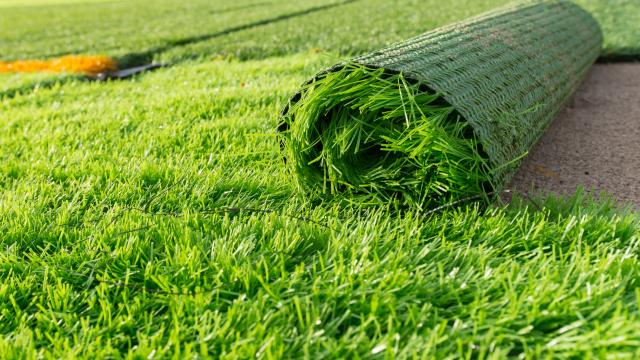With aeration, watering, mowing, and weeding, it can be a lot of work to keep a pristine grass lawn. But there are alternatives to traditional grass, like desert-style landscaping that takes minimal attention and watering, or rain gardens that have plants and shrubs designed to collect rainwater and filter toxins.
Another option, though, with almost no maintenance required, is synthetic grass. There’s no watering needed, and although it takes a bit of work to install, it’s worth it in the end. Here’s why you should make the switch to synthetic grass.
Why use synthetic grass?
Water conservation is one reason that artificial grass is great for you, your neighbourhood, and the planet. The EPA reported the “average American family uses 1,200 L of water per day, about 30 per cent of which is devoted to outdoor uses.” Much of that outdoor water is used on lawns and gardens — when calculated, the EPA found that lawn irrigation accounts for one-third of home water use, totaling nine billion gallons per day.
Artificial grass also doesn’t change colour. If the main draw to a healthy green lawn is its vibrancy, synthetic grass can achieve it without effort once it’s installed. It’s manufactured to protect against colour fading, so it won’t even fade over time.
If you’re worried about how it feels and concerned you’ll miss the natural grass between your toes, there’s a plethora of styles and types to choose from. You can pick the colour, length, and choose between home or golf style, which all simulate the feeling of real grass.
Of course, there are some cons of artificial turf, including that synthetic grass uses petroleum and plastics that make it not biodegradable. Synthetic grass also absorbs heat and feels much hotter to the touch than natural grass.
How to install synthetic grass
Installation of artificial grass isn’t easy on the front end — it’s labour-intensive, takes time, and requires specialised equipment. If you have the means, go with professional installation. If you want an idea of what it’s like, watch Synthetic Grass Warehouse run the process in their instructional video.
Before laying down your artificial grass, you’ll need to start by removing all elements from the area, including grass, any electrical, and at least four inches of soil. Next, install a bender board along the perimeter of the sectioned turf area to create a border for the synthetic grass to be laid down.
After the border’s in place, you’ll lay down the base layer of “gravel DG mix,” a mixture of sand and gravel to allow proper drainage. This layer also provides an even foundation for the turf, so you’ll want to make sure it’s level. Then wet the gravel mixture and pat it down so it’s even and compacted. You can use a power tool to pat it down (which you’ll need to rent or buy), or level it by hand with a specialised rake.
How to lay down artificial grass
Next, lay down a weed barrier — a layer of thin fabric to keep weeds from sticking through the turf. Then it’s time to lay down your grass, rolling it over the full area, or in sections, then cut to custom fit. Try to cut one-eighth of an inch too big for enough material to tuck the turf into place. Let the turf sit for 30 minutes to expand in the sun. Synthetic Grass Warehouse recommends cutting the turf in half in an S shape to allow mobility if you have one large piece.
Secure the turf in place with nails along the perimeter every six inches, and hammer them down three-quarters of an inch, so the turf is not pulled too tight. Then install U-shaped nails over the connecting seams to keep the two pieces together. Both types of nails will be hidden by the grass and unnoticeable to your eyes and feet.
After everything has been cut and laid, the final step is to apply the infill, which is an antibacterial sand-like substance that helps the turf stand upright and gives it some weight to stay in place and feel more like real grass. Power brush the turf so the infill can penetrate to the bottom, then use a seed spreader to lay down the infill evenly. Finally, go over the turf with a power brush again to help the infill set in place. All of the hard work pays for itself with the money, water, and time you’ll be saving on lawn care.

Leave a Reply
You must be logged in to post a comment.